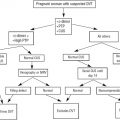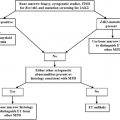The evaluation of a patient presenting with bleeding symptoms is challenging. Bleeding symptoms are frequently reported by a normal population, and overlap significantly with bleeding disorders, such as type 1 Von Willebrand disease. The history is subjective; bleeding assessment tools significantly facilitate an accurate quantification of bleeding severity. The differential diagnosis is broad, ranging from defects in primary hemostasis, coagulation deficiencies, to connective tissue disorders. Finally, despite significant clinical evidence of abnormal bleeding, many patients will have not an identifiable disorder. Clinical management of bleeding disorders is highly individualized and focuses on the particular symptoms experienced by the patient.
The initial assessment of a patient presenting with bleeding complaints includes a thorough history to determine several points regarding the bleeding symptoms: the pattern (primary vs secondary hemostasis), the severity, and the onset (congenital vs acquired). Bleeding assessment tools (BATs) may be useful in determining whether bleeding symptoms are outside the normal range. The laboratory investigations are directed by the clinical pattern of bleeding and family history; however, because Von Willebrand disease (VWD) comprises the most common and best characterized of the primary hemostatic disorders, VWD is often the first diagnosis within the broad differential to be considered. Clinical management of bleeding disorders is highly individualized and focuses on the particular symptoms experienced by the patient. Potential therapies include replacement of the factor that is deficient or defective (eg, Von Willebrand factor [VWF]/factor VIII [FVIII] concentrates in VWD, and platelet transfusion in platelet function disorder [PFD]) or indirect treatments, such as antifibrinolytics [tranexamic acid], desmopressin 1-deamino-8- d -arginine vasopressin [DDAVP], and hormone-based therapy (oral contraceptive pill [OCP] for menorrhagia).
The evaluation of a patient presenting with bleeding symptoms is complicated by several challenges. In contrast to severe bleeding disorders, such as severe hemophilia A (HA) and B (HB), or type 3 VWD, milder mucocutaneous bleeding symptoms are frequently reported by a normal population, and show a great deal of overlap with bleeding disorders, such as type 1 VWD. Bleeding histories are subjective, and significant symptoms may be interpreted as part of the spectrum of normal bleeding. The differential diagnosis is broad, ranging from defects in primary hemostasis (VWD, or PFDs), coagulation deficiencies, or dysfunction (mild HA/HB or dysfibrinogenemia) to connective tissue disorders (Ehlers-Danlos syndrome [EDS]). Many of the available laboratory investigations are not well standardized and can be difficult to interpret. Finally, despite significant clinical evidence of abnormal bleeding, many patients are not categorizable into any specific diagnostic category despite extensive testing. Awareness of these issues is of paramount importance and is discussed in the following sections.
Patient history
Bleeding History
The bleeding history includes a detailed assessment of the reported symptoms and is summarized in Table 1 . The following details should be determined:
- •
The consultant should investigate the nature of the bleeding, which includes inciting factors, frequency, duration, and severity, as well as complications, which include need and type of medical intervention for each bleeding symptom. Locations of bleeding include oral mucosal, cutaneous, gastrointestinal, genitourinary, intracranial, intramuscular, or intra-articular tissues.
- •
A thorough inquiry into past events is important. This inquiry includes the identification of past hemostatic challenges, associated bleeding complications, and level of intervention required. Hemostatic challenges include invasive surgical procedures, dental extractions, injuries, and wounds. In pediatrics, relevant hemostatic challenges include umbilical stump bleeding or bleeding at the time of circumcision.
- •
With easy or spontaneous bruising, the consultant should identify the location, size, and associated subcutaneous hematomas.
- •
When investigating menorrhagia, there are many relevant historical facts. The hematology consultant should determine the onset of menorrhagia (whether it was since menarche), duration of menses, number of pads/tampons needed throughout the day, history of iron deficiency, and previous treatments such as OCPs, progesterone impregnated intrauterine devices (IUDs), uterine ablation, or hysterectomy. Three findings predict abnormal blood loss: clots larger than approximately 2.5 cm, low serum ferritin, and the need to change a pad or tampon more than hourly. Bleeding symptoms surrounding childbirth, including postpartum hemorrhage, should be explored. Reproductive complications, such as recurrent miscarriages, are also pertinent.
- •
What measures have been used to treat or alleviate the bleeding symptoms?
- •
Has the patient ever had anemia requiring treatment with iron supplementation or transfusion?
| Symptom | Details |
|---|---|
| Bruising | Location, associated trauma, associated hematomas |
| Epistaxis | Frequency, duration, interventions required |
| Bleeding from minor wounds | Duration |
| Dental extractions | Duration of bleeding, intervention required |
| Menorrhagia | Duration of menses, amount of blood loss (pads/tampons used), size of clots seen |
| Postpartum hemorrhage | Amount and duration of blood loss, intervention required |
| Bleeding with surgery or injury | Amount and duration of blood loss, intervention required |
| Muscle hematomas, hemarthrosis | Associated trauma, history of recurrence |
| History of gastrointestinal/genitourinary/central nervous system bleeds | Associated anatomic lesions and treatment required |
| Iron deficiency | Requiring oral/intravenous iron and red cell transfusion |
| Family history | Of bleeding symptoms or bleeding disorder, consanguinity |
| Medical history | Medications and comorbidities |
In addition, the clinician should determine whether the bleeding history supports a primary versus an acquired disorder by the presence of:
- •
A family history of increased bleeding symptoms or a bleeding disorder
- •
Consanguinity
- •
Comorbidities such as renal disease, liver disease, autoimmune disease, lymphoproliferative disease, myeloproliferative neoplasm, plasma cell dyscrasia, cardiac valve disease, hypothyroidism
- •
Medications with particular attention paid to the use of aspirin (ASA), nonsteroidal antiinflammatory drugs (NSAIDs), clopidogrel, and anticoagulants (both generic and trade names should be used when asking patients about these medications). It is also important to inquire about alternative and complementary medications. For example, the commonly used herbal medications garlic, ginkgo, and ginseng may have an effect on platelet function and increase in bleeding symptoms.
The number and quality of symptoms reported by a patient may be influenced not only by education, family background, and personality but also by the type of data ascertainment because bleeding histories are subject to physicians’ interpretation. These factors contribute to the overlap between mild mucocutaneous bleeding symptoms reported by patients with mild to moderate bleeding disorders and those reported by normal individuals; healthy controls may report bleeding symptoms as frequently as individuals with known bleeding disorders. A review of the information that compared individuals with VWD with normal populations is presented in Table 2 to highlight this issue. Similarly, a positive family history is also frequently reported among healthy individuals. For example, in 1 cohort study, in 44% of healthy children undergoing tonsillectomy, parents and guardians reported a family history of bleeding. The points in the history, which are most supportive of a bleeding disorder, include bleeding after hemostatic challenges, intramuscular or intra-articular bleeds, a positive family history of an established bleeding disorder, and positive responses to multiple questions pertaining to bleeding. Conversely, a negative family history does not exclude a bleeding disorder. For example, 30% to 40% of patients with hemophilia have de novo mutations and lack a family history.







